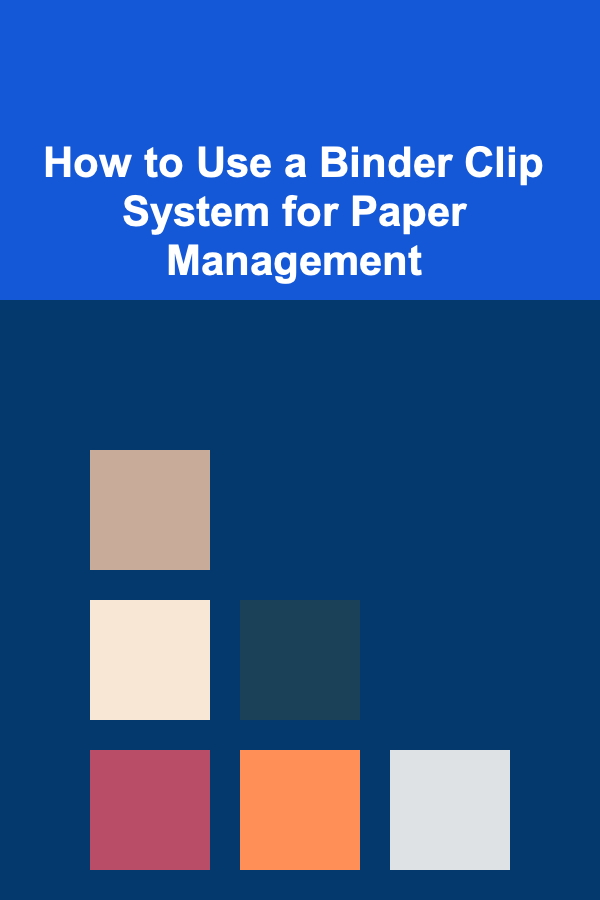
How to Use a Binder Clip System for Paper Management
ebook include PDF & Audio bundle (Micro Guide)
$12.99$8.99
Limited Time Offer! Order within the next:

In an increasingly paperless world, the physical management of documents can still pose challenges, especially when it comes to organizing and decluttering. Binder clips---those simple yet effective tools---can revolutionize how you handle paperwork, making it easier to sort, store, and retrieve important files. This in-depth guide will explore how to implement a binder clip system for effective paper management, covering everything from setup to maintenance.
Introduction
Managing paper efficiently has become an essential skill in both personal and professional settings. With endless bills, receipts, notes, and other documents piling up, finding an intuitive and straightforward solution is key. Enter the binder clip---a widely available and adaptable tool that can streamline your approach to paper management. This article will provide a step-by-step process on how to set up and maintain a binder clip system tailored to your specific needs, ensuring that you stay organized and focused.
Understanding Binder Clips
1. What Are Binder Clips?
Binder clips are multifunctional stationery items made of a folded piece of metal wire and a rectangular clip. They come in various sizes and strengths, designed to hold together multiple sheets of paper securely. Unlike traditional paperclips, binder clips have a more robust grip, allowing them to accommodate thicker stacks of documents.
2. Types of Binder Clips
There are several types of binder clips to consider:
- Standard Binder Clips: These come in small, medium, large, and extra-large sizes, perfect for different thicknesses of paper.
- Mini Binder Clips: Smaller and ideal for fewer sheets or as a decorative touch.
- Plastic Coated Clips: These offer a more aesthetic option while providing the same functionality.
Choosing the right type depends on your specific needs and the volume of papers you manage.
The Benefits of Using a Binder Clip System
Implementing a binder clip system for paper management offers numerous advantages:
- Cost-Effective: Binder clips are inexpensive and readily available, making them accessible for most budgets.
- Versatile: They can be used for various purposes, including holding documents together, serving as bookmarks, or even creating DIY organization tools.
- Space-Saving: Binder clips allow for efficient vertical storage of paper, helping to declutter desks and workspaces.
- Easy Access: As they hold papers together without permanently binding them, you can easily add or remove documents as needed.
- Flexible Organization: The ability to categorize and color-code documents makes it easy to find what you need quickly.
Choosing the Right Binder Clips
Selecting the appropriate binder clips is crucial for your paper management system. Here are some tips:
1. Assess Your Needs
Evaluate the types of documents you frequently handle. Consider their thickness, quantity, and how often you will access them. Choose clip sizes accordingly.
2. Quality Matters
Opt for high-quality binder clips that won't bend or break easily. Investing in durable clips ensures longevity and reduces the need for replacements.
3. Variety
Consider purchasing a variety pack that includes multiple sizes. This versatility allows for better accommodation of different document types.
Setting Up Your Binder Clip System
Once you've gathered your supplies, it's time to set up your binder clip system.
1. Categorizing Your Documents
The first step in setting up your binder clip system is categorization. Here are some common categories to consider:
- Financial Documents: Bills, bank statements, tax documents
- Work-Related Papers: Project proposals, meeting notes, reports
- Personal Files: Health records, insurance papers, personal correspondence
- Creative Materials: Inspiration clippings, sketches, brainstorming notes
2. Determining Storage Solutions
Think about how you'll store your categorized documents once they're clipped. Here are some options:
- File Boxes: Use durable file boxes for a clean, compact storage solution.
- Desk Organizers: Keep frequently accessed documents near your workspace.
- Portfolios: For creative materials, consider a portfolio case that keeps your papers flat.
Organizational Strategies with Binder Clips
To make the most of your binder clip system, consider implementing additional strategies for organization:
1. Color-Coding
Color coding is an effective way to enhance visual organization:
- Assign Colors: Designate specific colors for each category. For example, use green clips for financial documents and blue for work-related papers.
- Visual Appeal: Color coordination not only enhances organization but also adds an aesthetic element to your space.
2. Labeling
Labeling helps to identify contents quickly:
- Use Tags: Attach labels to the clips or on the edges of the documents that indicate the category.
- Write Clear Descriptions: Ensure labels are concise yet descriptive enough for quick identification.
3. Utilizing Different Sizes and Types
Different sizes and types of binder clips serve various functions:
- Large Clips: Use for holding larger stacks of paper.
- Mini Clips: Ideal for smaller documents or bookmarks.
- Decorative Clips: Enhance visual appeal and personalization.
Maintaining Your Binder Clip System
An effective paper management system requires regular maintenance. Here's how:
1. Regular Reviews
Set aside time weekly or monthly to review your organized documents. Remove any outdated or irrelevant papers to keep your system current.
2. Adapt to Change
As your needs evolve, be ready to adjust your categories and organization methods. For instance, if a new project arises, create a new category accordingly.
3. Avoid Overloading Clips
Avoid overloading binder clips. Too many documents in one clip can lead to bending or breaking. Instead, use multiple clips when necessary.
Creative Uses for Binder Clips
Beyond standard document management, binder clips can be used creatively:
1. Bookmarking
Use mini binder clips as bookmarks for your books or planners.
2. Cable Management
Binder clips can help organize charging cables or headphones on your desk, preventing tangling.
3. Food Clips
In the kitchen, binder clips can seal open bags of snacks or ingredients, keeping them fresh.
4. Art Projects
For those inclined towards creativity, binder clips can be incorporated into art projects, adding unique elements to mixed media.
5. Wall Displays
Attach them to walls or boards to display photos, notes, or artwork in a casual, easily changeable format.
Common Challenges and Solutions
While a binder clip system is generally straightforward, challenges may arise. Here are some common issues and their solutions:
1. Clutter Accumulation
Challenge: Papers can pile up again, defeating the purpose of the organizational system.
Solution: Schedule regular cleaning sessions to review and declutter your papers. Aim to do this every month.
2. Difficulty Finding Items
Challenge: Despite being clipped, documents might still be hard to locate.
Solution: Implement a clear labeling system alongside color-coding. Maintain a master list of categories for reference.
3. Overwhelmed by Volume
Challenge: Large volumes of papers can make management cumbersome.
Solution: Break down tasks into manageable chunks. Address one category at a time to avoid feeling overwhelmed.
4. Losing Clips
Challenge: Binder clips can sometimes get lost in clutter.
Solution: Designate a specific container or drawer for storing extra clips. Keeping them in an accessible location avoids misplacement.
Conclusion
Using a binder clip system for paper management is a practical and versatile solution to organizing documents effectively. By understanding the benefits of binder clips, choosing the right ones, categorizing your documents, and implementing strategies like color coding and labeling, you can create an efficient system tailored to your specific needs.
Regular maintenance and adaptation will ensure that your system remains functional and relevant over time. Embrace the simplicity of binder clips, and transform the way you manage paper to foster a more organized and productive environment. Whether at home, school, or work, a binder clip system can make a significant difference in how you approach paper management. Start today, and discover the ease and efficiency this simple tool can bring!
Reading More From Our Other Websites
- [Organization Tip 101] How to Organize Your Media Collection
- [Biking 101] The Ultimate Guide to Cycling Injuries: Prevention, Recovery, and Rehabilitation
- [Personal Care Tips 101] How to Choose Mouthwash That Works with Your Toothpaste
- [Home Cleaning 101] How to Use Vinegar as a Powerful Cleaning Agent
- [Home Cleaning 101] How to Clean Your Oven Without Harsh Chemicals
- [Stamp Making Tip 101] Creative Playtime: 5 Simple Stamp-Making Projects for Little Artists
- [Metal Stamping Tip 101] Best Metal Stamping Techniques for Creating Stunning Personalized Gifts
- [Organization Tip 101] How to Use Seasonal Changes to Reorganize Pet Supplies
- [Home Budget 101] How to Use Cash-Back Apps to Save on Home Expenses
- [Home Maintenance 101] How to Winterize Your Home to Save Energy

How to Create a Jewelry Maintenance Schedule
Read More
How to Make a Checklist for Conducting Competitor Analysis
Read More
How To Open a Specialty Food Store (e.g., Gluten-Free, Vegan)
Read More
How to Profit from Affiliate Marketing
Read More
How to Refresh Your Home with a Low-Cost Paint Job
Read More
The Art and Science of Birthday Cake Decoration
Read MoreOther Products

How to Create a Jewelry Maintenance Schedule
Read More
How to Make a Checklist for Conducting Competitor Analysis
Read More
How To Open a Specialty Food Store (e.g., Gluten-Free, Vegan)
Read More
How to Profit from Affiliate Marketing
Read More
How to Refresh Your Home with a Low-Cost Paint Job
Read More